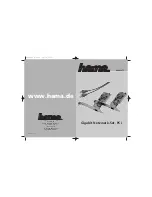
Chapter 3
Hardware Overview
3-8
ni.com
•
Delayed acquisition—Use either software or triggers to start
acquisitions instantaneously or after skipping a specific number of
frames. You can use delayed acquisition for post-trigger applications.
Serial Interface
The IMAQ 1426 provides serial connections to and from the camera
through two LVDS pairs in the Camera Link cable. All Camera Link serial
communication uses one start bit, one stop bit, no parity, and no hardware
handshaking.
The IMAQ 1426 supports the following baud rates: 56000, 38400, 19200,
9600, 7200, 4800, 3600, 2400 bps, 2000, 1800, 1200, 600, and 300 bps.
You can use the serial interface interactively with MAX and
clsercon.exe
, or programmatically with LabVIEW and C.
Interactively:
•
MAX—Use MAX with a camera file containing preprogrammed
commands. When an acquisition is initiated, the commands are sent to
the camera.
•
clsercon.exe
—Use the National Instruments terminal emulator for
Camera Link,
clsercon.exe
, if a camera file with preprogrammed
serial commands does not exist for your camera. With
clsercon.exe
, you can still communicate serially with your camera.
Go to
<NI-IMAQ>\bin
to access
clsercon.exe
.
Programmatically:
•
LabVIEW—Use the serial interface programmatically, through calls
to the NI-IMAQ driver using the IMAQ Serial Write and IMAQ Serial
Read VIs. Go to
<LabVIEW>\vi.lib\vision\driver\
imaqll.llb
to access these files.
•
C—Use the serial interface programmatically, through calls to the
NI-IMAQ driver using
imgSessionSerialWrite
and
imgSessionSerialRead
.
Note
IMAQ Serial Read, IMAQ Serial Write,
clsercon.exe
,
imgSessionSerialRead
, and
imgSessionSerialWrite
are used for directly
accessing the IMAQ 1426 serial port and are not required for most users.
National Instruments also fully supports the recommended serial API
described in the
Specifications of the Camera Link Interface Standard for
Digital Cameras and Frame Grabbers
manual.
















































